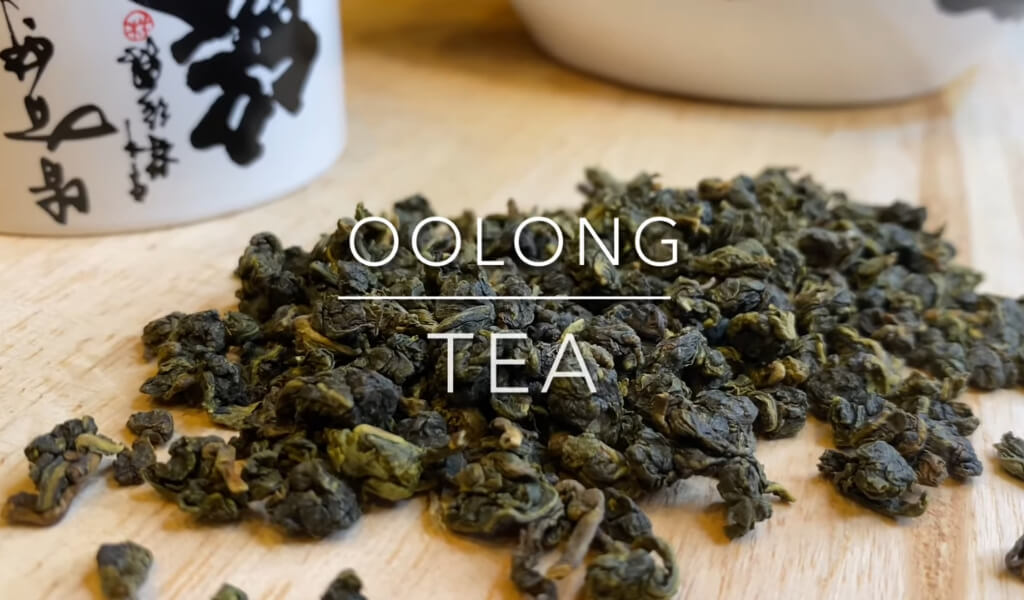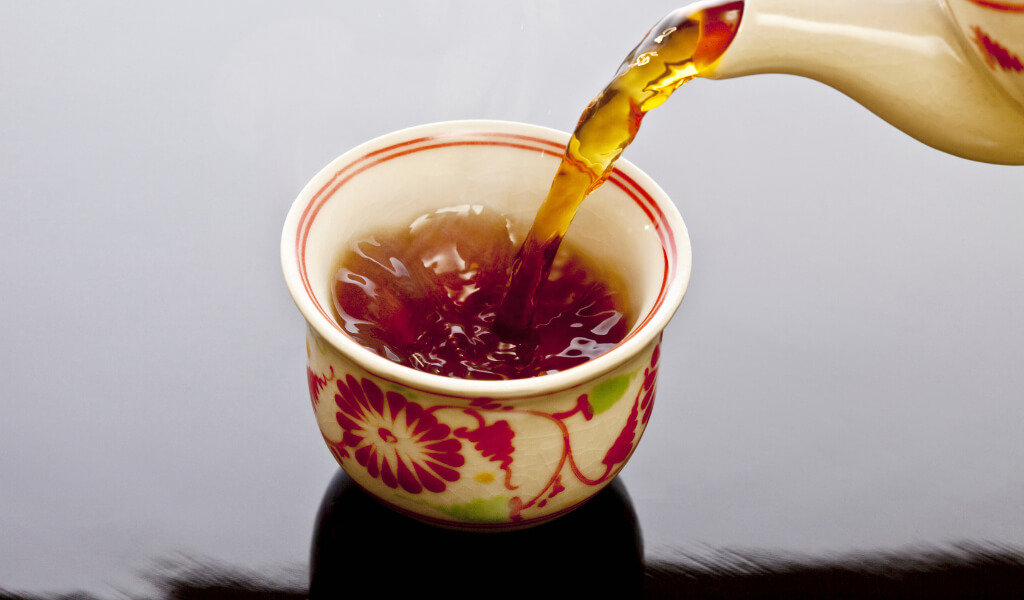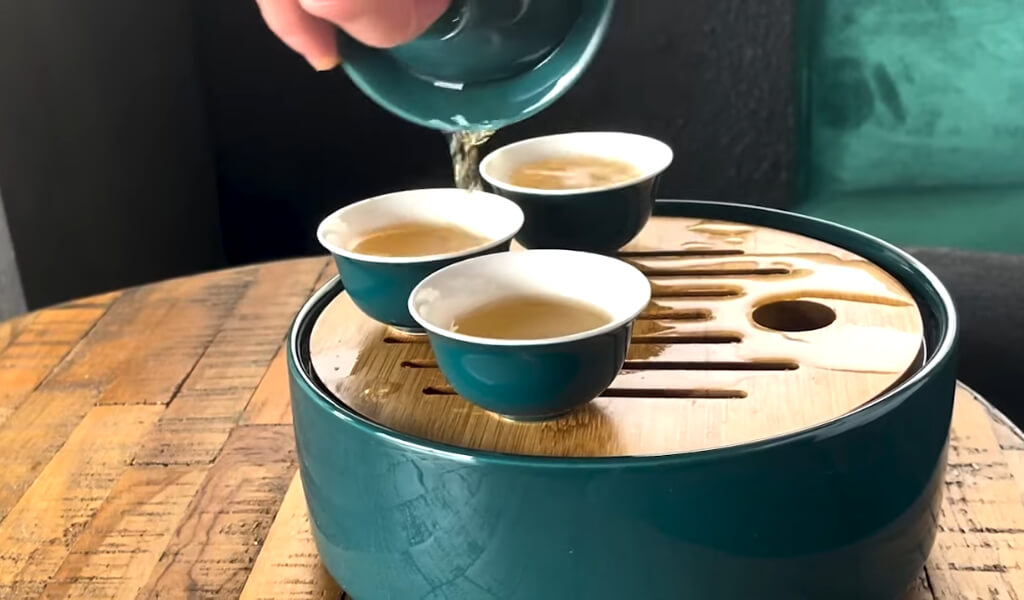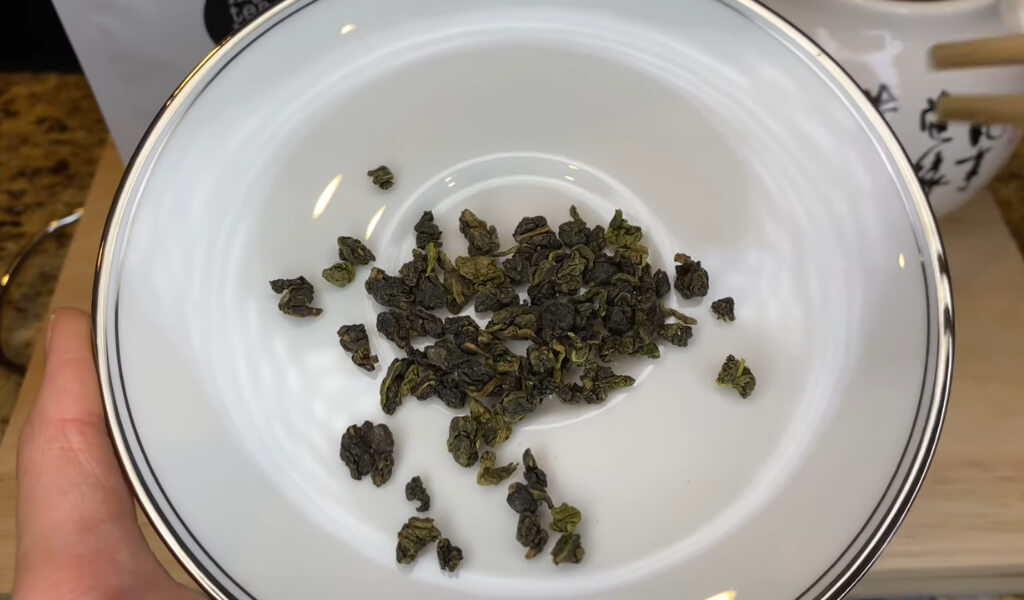Ever tried Oolong Tea, or as some folks call it, “Wulong” or “Black Dragon” tea? If not, or even if you have and you’re still wondering, “What does Oolong tea taste like?” you’re in the right place. Over the next few minutes, I’ll take you through the taste journey of this amazing tea. It’s quite the flavor adventure, I assure you.
So, let’s dive into the world of Oolong and its enticing flavors together.
What does oolong tea taste like?
Oolong tea offers a distinct taste with various flavors, influenced by its specific type. It carries a floral scent and a mildly sweet, fruity flavor complemented by a touch of nuttiness.
The reason for such a diverse taste palette lies in its unique processing. Oolong is partially fermented, a process sitting between green tea (unfermented) and black tea (fully fermented), which attributes to its unique “oolong taste”. This fermentation leads to a transformative taste that evolves in your mouth with each sip.
Other Taste like Oolong
Green Oolong
Also known as “jade” oolong, these teas offer a fresh, bright flavor profile. They possess vegetal notes and a floral, buttery body that is more complex than your typical green tea. Taiwanese green oolongs are particularly notable for their concentrated sweetness and unique terroir flavor.
Medium Roast Oolong
Offering a mellow, warming taste, medium roast or oxidation oolongs like Taiwanese dong ding develop warm spice notes and a deeper body with accents of honey, toasted grain, or white sesame. They possess a more woodsy character, offering a unique flavor experience that differs from the fruity flavors of black teas.
Heavily Roasted Oolong
Dark and intense in flavor, heavily roasted oolongs like Wuyi’s “cliff” teas or the dancong oolongs of Phoenix Mountain are often compared to coffee. They develop a robust, layered brew that adds notes of chocolate, nuts, and charcoal on top of the tea’s inherent honeyed sweetness, making them a treat for those who love bold flavors.
Here’s a comparison table of oolong tea flavor profile:
| Green Oolong | Medium Roast Oolong | Heavily Roasted Oolong | |
| Origin | Taiwan | Taiwan, China | China |
| Flavor Profile | Fresh, Fragrant | Mellow, Warming | Dark, Intense |
| Oxidation Level | Low | Moderate | Moderate |
| Roasting Level | Light | Medium | Heavy |
| Unique Characteristics | Floral, buttery body | Warm spice notes, woodsy character | Robust, layered brew, honeyed sweetness |
Read More:
- So, is oolong tea black tea?
- When to Drink Oolong Tea to Lose Weight?
- Let’s check out the article: where to buy oolong tea?
Does Oolong Tea Taste Good?
Yes, Oolong tea indeed tastes good! Its unique flavor profile results from the fermentation process, which harmoniously blends floral, sweet, and mildly toasty notes, offering a captivating experience to tea enthusiasts worldwide. Each variety of Oolong tea, distinct in oxidation level and derived from specific tea cultivars, offers a unique taste experience.
Whether you prefer a lighter, more floral taste or a darker, roaster brew rich in polyphenols, there’s an Oolong tea for every palate. This delightful complexity in taste, bursting with antioxidants, makes Oolong tea a standout in the world of teas. As a seasoned Oolong tea drinker, I can attest to its enticing taste and believe its unique fermentation-driven flavor profile will delight you too.
Factors that Affect the Taste of Oolong Tea
Where does the captivating aroma of oolong tea originate from? Let’s dive into this.
| Factors Affecting Oolong Tea Taste | |
|
Tea Frying
|
– Tea frying promotes aroma |
| – Fermentation enhances aroma | |
| – Wuyi rock tea shows complex reactions | |
|
Tea Making
|
– Aroma control in crafting |
| – Aroma-taste blend creates unique flavors | |
| – Diverse oolong aromas contribute to culture | |
|
Leaves
|
– Leaf variety influences flavor |
| – Tieguanyin’s large leaves for oolong | |
| – Longjing’s bud tips for green tea | |
|
Environment
|
– Environment affects aroma |
| – Planting, season, processing impact | |
| – Sunshine activates enzymes, improves aroma | |
Tea Frying
Locking in the Flavor: The process of tea frying brings out the unique aroma of oolong tea. Unlike green tea, which halts enzyme reactions, oolong tea promotes them through fermentation, giving it a rich aromatic profile. Particularly, Wuyi rock tea, characterized by its fixed aroma, underscores how the complex chemical reactions during tea frying can lead to a deep and inviting flavor profile.
Tea Making
Controlling the Aroma: Crafting the perfect cup of oolong tea is an art that focuses on controlling the aroma. The blend of aroma and taste creates a symphony of flavors that resonate uniquely with each tea drinker. The diversity in oolong tea aromas, each with varying polyphenols and caffeine in oolong tea, contributes to the vibrant palette of tea culture.
Leaves
Determining the Variety: The variety of the leaf, or the tea cultivar, plays a significant role in the tea’s flavor. For instance, large, thick leaves like those of Tieguanyin are ideal for oolong tea, while the well-grown bud tips of Longjing tea are better suited for green tea.
Environment
Influencing the Aroma: The environment significantly influences oolong tea’s aroma. Planting conditions, season, and even processing techniques such as drying, shaking, and re-baking all contribute to the final aroma. Sunshine, for example, evaporates water and activates enzymes, which enhances the tea’s aroma.
How to Enhance the Flavor of Oolong Tea
If you want to enrich the flavors of your oolong tea, I’ve gathered some tips on how to make oolong tea from my personal experiences and shared wisdom at my local Friday tea club.
Choose High-Quality Loose Leaf Tea: This might sound obvious, but the quality of your oolong tea leaves plays a crucial role in the final taste. Always opt for loose leaves over pre-packaged tea bags. Loose leaves tend to retain more of their natural oils, contributing to a fuller, richer flavor profile.
Use Purified or Filtered Water: You’d be surprised how much water’s quality and mineral content affects the taste of your oolong tea. Avoid tap water, as it can contain minerals and chemicals that can alter the taste of your tea.
Correct Brewing Temperature and Time: Oolong tea tastes best when brewed between 185-205 degrees Fahrenheit for about 3-5 minutes. Overheating can lead to bitterness, while not heating enough can lead to a weak and flavorless brew.
Multiple Infusions: Oolong tea is known for retaining flavor through multiple infusions. Often, the second or third infusion is considered the best. So, don’t quickly discard your tea leaves after the first step.
Proper Storage: To preserve the flavor of your oolong tea, store it in a cool, dry place away from light, moisture, and strong odors. Proper storage helps retain the aroma and flavor for longer.
The Right Teaware: Traditionally, oolong tea is brewed in a small, unglazed clay teapot or a gaiwan. These materials enhance the tea’s flavor by absorbing some of the oils.
You may greatly improve your experience of drinking tea by including these components and making your oolong tea mindfully. Have fun exploring the flavorful world of oolong tea!
Oolong tea flavor pairings
Here are a few of my personal favorites:
Dark Chocolate
This sweet delight complements the powerful flavor of the thoroughly roasted Oolongs remarkably well. A captivating taste combination is produced by balancing the sweetness of Oolong with the mildly bitter tones of dark chocolate.
Fruits, Especially Citrus
The tartness of citrus fruits such as oranges, lemons, or grapefruits can wonderfully contrast the smooth, floral notes of Oolong tea, particularly lighter, green Oolongs. The bright, citrusy flavors can bring a refreshing edge to your tea experience.
Nuts (Almonds, Cashews, Walnuts)
Nuts are another excellent pairing for Oolong tea, particularly for medium roast Oolongs. The richness of nuts marries well with the warm, toasty flavors of the tea, resulting in a delightful and satisfying combination.
Cheese, Especially Soft Cheeses
Believe it or not, cheese and tea can be a fantastic combination. Soft cheeses such as Brie or Camembert, with their creamy texture and rich flavors, pair wonderfully with the sweet, floral notes of Oolong tea.
Spiced pieces of bread or Cookies
The spices in baked goods like cinnamon rolls, ginger cookies, or nutmeg-laced bread can complement the complex flavor profile of Oolong tea. A sip of tea after a bite of spiced bread can reveal new depths in the food and the tea.
Honey or Maple Syrup
Adding a touch of honey or maple syrup can sweeten your Oolong tea and complement its naturally sweet undertones. It’s a simple way to enhance the floral and fruity notes in the tea.
Grilled or Roasted Meats
For a savory pairing, grilled or roasted meats, particularly those with a bit of spice or caramelization, can beautifully complement the robust, layered flavors of heavily roasted Oolongs.
Asian Cuisine
The subtle complexity of light Oolongs pairs well with various Asian dishes, including sushi, steamed dumplings, or light stir-fries. The tea’s clean and refreshing qualities can cleanse the palate after enjoying spicy or rich flavors.
Fall Fruits
Autumnal fruits such as apples, pears, or figs can beautifully complement the warm and roasted characteristics of dark Oolongs. These flavors evoke a relaxing and comforting experience.
Maple Syrup
Dark Oolongs, with their toasty and bold flavors, pair wonderfully with the earthy sweetness of maple syrup. Try enjoying the tea alongside pancakes or waffles drizzled with maple syrup.
In conclusion
Oolong tea delivers a flavor that is absolutely delicious and a joy for connoisseurs. Oolong tea tantalizes the taste receptors with its rich flavor profile, which combines flowery, sweet, and faintly toasted aromas. Oolong tea offers a variety of taste characteristics to suit every palette, from light and energizing types to deeper and more powerful ones.
I hope this article has provided valuable insights into the question, “What does oolong tea taste like?” Thank you for joining me on this flavorful journey.
If you found this information helpful and enjoyable, please share this article on your favorite social networks to spread the joy of oolong tea to others. Cheers to a delicious cup of oolong tea!
Spiritea Drinks thank you.
FAQs
Do you put milk in oolong tea?
While adding milk to oolong tea is not traditional, it ultimately comes down to personal preference. Oolong tea has a delicate and nuanced flavor profile, and adding milk can overpower its unique characteristics.
Is oolong tea sweet?
Yes, the natural sweetness of oolong tea can vary depending on the specific variety and processing techniques. Oolong teas generally exhibit a pleasant balance of sweetness and other flavor notes, such as floral, fruity, or toasty nuances. Some oolongs have a naturally sweeter profile, while others may be more nuanced with hints of sweetness.
What does oolong milk tea taste like?
Milk Oolong tea from Taiwan is famous for its creamy and buttery flavor. Authentic Milk Oolong offers a delightful fragrance of flowers and a gentle roasted and rolled tea leaf infusion that imparts a sweet taste of butter and milk.
The flavor can vary depending on the specific oolong tea used and the ratio of tea to milk.
What milk goes best with oolong tea?
When selecting milk for oolong tea, it’s best to choose lighter and more subtle options that won’t overpower the tea’s delicate flavors. Unsweetened almond milk, oat milk, or coconut milk can be good choices as they provide a creamy texture without adding a strong taste.
What can I mix with oolong tea?
You can mix various ingredients with oolong tea to enhance its flavors and create interesting blends. Some popular options include adding fresh fruits like lemon, orange, or peach slices for a burst of citrusy or fruity notes.
Does oolong taste good with honey?
Yes, oolong tea pairs wonderfully with honey. Besides the health benefits of oolong tea, the sweetness and richness of honey can enhance oolong tea’s natural floral or fruity notes. Your oolong tea may be enhanced by adding a drizzle of honey to get a beautiful balance of tastes that adds depth and a hint of sweetness.
Is Oolong tea similar to green tea in taste?
While oolong and green tea share some similarities, they have distinct taste profiles. Oolong tea is often characterized by a more complex flavor with a balance of floral, sweet, and toasty notes, while green tea tends to have a more vegetal and grassy taste.
Does Oolong tea taste like black tea?
Oolong tea falls between green tea and black tea in terms of taste. It is less oxidized than black tea, offering a milder and less robust flavor, but more oxidized than green tea, resulting in a deeper and more complex taste.
Does Oolong tea taste good with milk?
While adding milk to oolong tea is not traditional, some individuals enjoy the combination. Adding milk can create a creamy and smoother texture, altering the flavor profile and providing a different taste experience.
Is Oolong tea naturally sweet, or does it need sweeteners?
Oolong tea has a natural sweetness, but the level of sweetness can vary among different varieties. Depending on personal preference, some individuals may prefer to add sweeteners like sugar or honey to enhance the sweetness further.
Can oolong tea taste bitter if brewed incorrectly?
Improper brewing, such as oversleeping or excessively hot water, can make the oolong tea taste bitter or astringent. It’s essential to follow proper brewing guidelines to avoid bitterness and enjoy the intended flavor profile.
Does oolong tea taste better with or without sweeteners?
Whether to add sweeteners to oolong tea is a matter of personal preference. Some individuals appreciate the natural sweetness of oolong tea without additional sweeteners, while others may enjoy a sweetness to enhance the overall taste experience.
I’m Shanna, creator of Spiritea Drinks. I’m all about teaching people to grow their own food, tea, cook what they harvest, and eat with the seasons.




